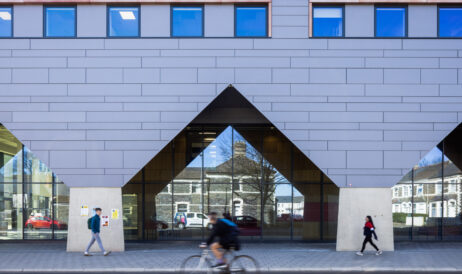Stephen Dolphin, Divisional Director for Organisational Change, on how Stride Treglown has developed resilience through well-planned business change projects that have enabled us to respond to world-changing events.

In the last six months, we have seen some of the biggest upheaval and changes in our society since World War II. Life has changed, possibly forever, and with it work has had to adapt rapidly.
Some organisations will have been in much better shape than others to weather the storm. Although we didn’t foresee a global pandemic, we had – pre-Covid-19 – started to put in place several business change projects to improve working environments, increase efficiencies, and ultimately build our everyday resilience.
Trust, respect and wellbeing
An important aspect of the culture of our business is building reciprocal relationships. This means we strive for openness and honesty with our employees about organisational operations. The subtle difference between the idea of reciprocity and the perhaps more cynical term ‘transactional relationship’ is the fact that the former is built on trust and mutual respect.
Recognising that wellbeing and mental health is important, we have always kept this as a focus whenever we undergo a change or organisational improvement. Nicola Rich, our internal HR Consultant led us through becoming the first UK business to receive an ‘Excellent’ rating across all aspects of the Workplace Wellbeing Charter, as well as championing Mental Health First Aiders within the organisation.
Agile and flexible working
One of our big achievements last year was publishing our agile and flexible working handbook.
The handbook develops existing agile and flexible working patterns we had already put in place before the pandemic struck. Some examples of these include ‘Flexidays’; flexible working around ‘core hours’; and a home working system.
A homeworking system
There is often a tendency to assume that something like a home working system is all about the technology that delivers it, but those with experience will remind you that technology is only ever an enabler, not the solution itself.
Finding a scalable, reliable and secure solution was vital for us. Equally as important were the conversations we had internally about how we wanted home working to look – what we wanted people to use it for; how we would safeguard against employees feeling isolated; and what sort of communications and processes would be needed to support those working from home. Without these important considerations we saw a risk that new developments could make things worse, not better.
The storm strikes – adapting to new situations
In March 2020 things changed dramatically and we had to respond quickly in several ways.
Because internal communication is so important for us, the senior leaders took to issuing daily updates about what was happening around the business and the impact of the pandemic. Finances, project delivery, IT, our people and HR, and of course internal and external communication were all shared and discussed. Listening to staff feedback was essential during these updates.
We quickly recognised that some of our employees were finding the change in home and work life was having a negative effect; especially those with caring responsibilities. Nicola Rich and Lucy Blannin (HR Advisor) ran workshops for our team leaders on how to manage and lead remotely as well as sessions for parents with tips on balancing work and home life. This was supported by a wider Healthy Homeworking campaign developed with our marketing team who took on a much more internal facing role during the early days of the pandemic.
The recently introduced home working system was rapidly scaled-up to support many more users. In under a week we transformed a system designed to allow 30 people to work from home at once, to one able to support around 250 people simultaneously working remotely.
Everyone has been impacted by the restrictions imposed as a result of Covid-19. Unsurprisingly, we found that employees were missing some of the social aspects of working together. Mentoring and the informal sharing of knowledge and ideas has also become harder. Despite this, there are some clear positive shifts that we have seen during this period which we are keen to build on.
What lies ahead – our reinvention phase
We have identified and started work on three work streams looking at:
- People and their working practices
- Travel
- Home and office spaces
From the people perspective, we are progressing team leader development programmes to help our leadership tier adjust to the changes brought about by managing remote and disparate teams.
We want to maintain the reduced travel patterns of the last six months and we’re exploring the best ways we can do that.
What becomes of office buildings? It’s probably too early to say, although we do know that those working from home might need more support in the future. This is where our immediate focus is. We also need to revisit our agile and flexible working handbook and internal policies to better-reflect the shift we have made, as a company and wider society, in our working patterns.
There seems to be an assumption that offering employee flexibility is a “no-brainer” and should be done at any cost. Offering agile and flexible working to employees, especially during a challenging time, is hard work. It requires the clear commitment of the senior leadership teams and effective learning and development programmes, all founded on the basis of mutual trust.
How does your business approach resiliency? We’d love to hear how other companies are handling their own changes to people, travel, and spaces. Get in touch with Stephen Dolphin or join the conversation on our social media channels #TalkingSpaces014.






